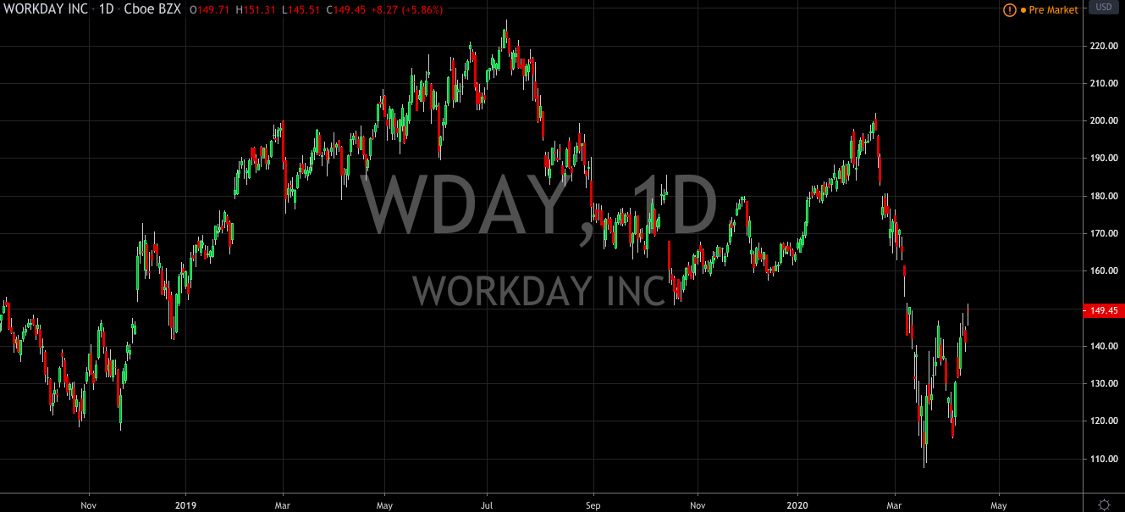Having traded hands as high $42 on their first day of trading last June, few on Wall Street would have predicted that shares of Slack
NYSE: WORK would be effectively half that by the end of the year, but that’s exactly what happened.
It wasn’t the only fresh-faced and bushy-tailed tech name to fall victim to a pumped-up IPO price that was quickly deflated. Investors in Uber NYSE: UBER and Lyft NASDAQ: LYFT know that feeling only too well by now. 2019 will be remembered as the year many high flying names were brought quickly back to earth. But can 2020 be the year that at least one of them turns the story around? Based on Slack’s Q3 earnings report in early December, they’re going to give it their best shot.
As we covered last month, the EPS numbers were the headline grabbers with a solid beat on analyst expectations. While they’re still not quite in the black, they’re not nearly as much in the red as analysts thought they might be. Revenue also came in on top and showed an impressive 60% growth year on year which also topped the consensus. In a sign of a company fighting for that hockey stick growth curve, they now have more than 50 customers paying over $1 million in annual recurring revenue.
Stiff Competition
However, a 50% decline in the share price is still a 50% decline in the share price and investors will need to be mindful of the uphill battle ahead.
November’s report that Microsoft NASDAQ: MSFT had passed the 20 million daily users mark for their Microsoft Teams solution put paid to any end of year rally for Slack. It’s worth noting that this figure had jumped over 50% from the 13 million daily users they counted back in June. The 20 million figure for the rival solution is now almost twice as high as Slack’s and is sure to become a regularly measured metric in the quarters ahead.
Considering that Microsoft Team has been on the market for over two years and is bundled in with the juggernaut Office 365 solution, Slack is still very much the new kid on the block. To this end, Wedbush was out around the same time with a $14 price target, noting, in particular, the competitive challenge from one of the world’s biggest tech companies.
Better Days Ahead
However, it’s not all bad news. Piper has a $30 price target for Slack’s stock and technically speaking it’s starting to look as if it wants to head there. Having come down to the $20 mark in October, shares have bounced along that line steadily enough which suggests that there are consistent buyers to be had. To the upside, it’s been bouncing back from the $23 mark and has had trouble breaking through here. But shares seem determined to start of 2020 on the front foot and have rallied 15% in the past two weeks to be right at the top of the range after setting consistently higher lows. RSI has been rising steadily with them and is bullishly healthy at 60 while the MACD had a bullish crossover as recently as December 24th.
Having taken a beating in its first 6 months, it’s starting to look like the bears are running out of steam and the bulls are about to take control. Despite the stock falling 50% from its IPO price into the new year, there’s a lot of good internal momentum for investors to keep in mind as we swing into 2020. If it can break above and hold $24, it should be clear sailing towards $28. Another impressive earnings report would then do a lot of quelling any concerns about being competitive and might finally give Slack the chance to justify its IPO price.

Before you make your next trade, you'll want to hear this.
MarketBeat keeps track of Wall Street's top-rated and best performing research analysts and the stocks they recommend to their clients on a daily basis.
Our team has identified the five stocks that top analysts are quietly whispering to their clients to buy now before the broader market catches on... and none of the big name stocks were on the list.
They believe these five stocks are the five best companies for investors to buy now...
See The Five Stocks Here
MarketBeat's analysts have just released their top five short plays for July 2025. Learn which stocks have the most short interest and how to trade them. Enter your email address to see which companies made the list.
Get This Free Report
Like this article? Share it with a colleague.
Link copied to clipboard.